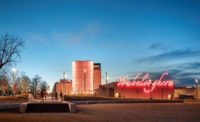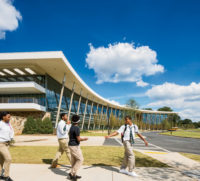When Melissa Zaikos, founder, CEO, and principal of the Intrinsic Charter School in Chicago, was looking for a site for the new school, she visited the former Shannon Lumber Company on West Belmont Avenue in the northwest section of the city. 'I fell in love with the barn when we walked in,' she recalls of the bowstring truss structure (once an open shed) with solid wood columns that rise as high as 30 feet. Constructed in 1954, it is the northernmost extension of two connected structures built in 1911 and 1928, for a family-owned lumber business, that seemed far more suitable to adapt for Intrinsic's innovative curriculum than a traditional school building. With a blended learning program, Intrinsic employs a unique classroom configuration. 'The school is designed particularly to this model,' says Larry Kearns, principal of Wheeler Kearns Architects, the firm that transformed the commercial building into the new facility.
Additional Content:
Jump to credits & specifications
Kearns and his team began by razing a caretaker's house-cum-sales-office at the southern end of the complex, and replacing it with a steel-frame structure. This was linked to the gutted buildings to create a school that is 456 feet long and 94 feet wide, with a roof covered by insulating foam, an exterior clad in insulated metal panels, and windows installed primarily on the west and south facades. The existing structures have brick bearing walls with long-span roofs and bowstring trusses (though the 1928 structure's wood trusses had been replaced with steel joists). Because of its length, the building was subdivided into three fire zones with separate exits.
Founded in 2013, Intrinsic moved to its permanent home last fall. With a capacity for 925 students from grades seven through 12, it is currently occupied by 430 students. A single-loaded corridor along the west wall dominates the long interior with ample glazing, while double-height spaces and single-story stacked zones are arrayed along the east wall. The hallway has polished concrete floors and clusters of soft, colorful seating for informal gathering or group work.
The central design feature is the unusual classrooms along the east wall. Called 'tandem pods,' these are pairs of large, linked rooms, one pair for each grade of up to 180 students. One pod per pair is for science, math, and technology studies; its twin is for humanities. Students rotate among various blended-learning methods, which integrate technology with peer-to-peer or teacher-led instruction. Along the walls is the 'coastline''counter-style desks where students wearing headsets work individually on digital lessons using Chromebooks'while elsewhere in the room, students on rolling chairs can come together for small-group learning. Other students gather under a big orange pendant at the 'exchange table' to work on team projects, or they meet with a teacher at a central counter or 'genius bar' (with apologies to Apple). An enclosed seminar room and a lab, for more conventional teaching, are tucked in between the pods. Up to eight teachers work with students in each pair of pods.
The architects learned from the innovative school's early trials. For example, the students used rolling chairs at its temporary campus: 'The student groupings looked like bumper cars at a carnival,' says Kearns, 'and brought chaos.' Now the 'coastline' and exchange tables have stationary seating.
One big design challenge was bringing daylight to the pods. Along most of the eastern edge of the building, on the property line, the architects were not able to punch in windows. Instead, the tandem pods draw daylight through the interior glass that fronts the windowed corridor, and five of the 12 pods incorporate high-performance skylights. 'We needed dispensations from the city for the borrowed daylight and to use skylights,' says Kearns.
In the 'barn' that had so attracted Zaikos, the architects built what they call 'a ship in a bottle': a two-story steel-frame structure, inserted in the 1954 building's south end, that contains a tandem pod stacked on each floor and administrative offices on the second level overlooking the gymnasium. The 38-foot-high gym, with the exposed bowspring truss, also flexes as a cafeteria'with mobile tables'as well as a community space that can be isolated from the academic areas at a common entry vestibule.
With a design tailored to the highly individualized curriculum, it might seem as if Intrinsic would be a free-for-all. But students were orderly as they lined up in the corridor'two ninth-grade girls in green polo shirts (each grade wears its own color) declared the school 'really strict!' The level of student autonomy, particularly in the lower grades, is limited and continues to be tuned. Says Zaikos, who plans to open more schools on this model, 'The building is important to learning about the learning.'
|
Watch a video about the Intrinsic School produced by Wheeler Kearns Architects and 80JD. |
CreditsClient: Intrinsic Schools Owner: Intrinsic Schools Architect: Personnel in architect's firm who should receive special credit: Engineers: Consultant(s): Acoustical: Threshold Acoustics General contractor: Clune Construction Company Photographer(s): Size: 58,000 square feet Project cost: Withheld Completion date: September 2014 |
SpecificationsStructural system Existing buildings were bonded common brick walls with heavy timber bow string truss roofs; New additions and floors within are structural steel frames with composite concrete deck floors. Exterior cladding Metal Panels: Kingspan, Benchmark Panels; Kingspan, Azteco Panels Metal/glass curtain wall: Roofing Windows Glazing Skylights: Wasco Skylights, Lumira with Aerogel Doors Wood doors: Graham Wood Doors Fire-control doors, security grilles: Hardware Closers: LCN Exit devices: Von Duprin Security devices: Detex Interior finishes Suspension grid: Armstrong Cabinetwork and custom woodwork: Paints and stains: Sherwin-Williams, interior; Modac by MAB, exterior Special surfacing: Crane Composites, fiberglass reinforced plastic (FRP) wall surface in kitchen Floor and wall tile: Daltile (bathrooms) Resilient flooring: Gerflor Terraflex, gym Carpet: Interface Special interior finishes unique to this project: Furnishings Chairs: Steelcase, Node chairs; Vanerum Stelter, Opti+ chairs Tables: Vanerum Stelter; First Office Upholstery: Camira Blazer wool fabric (on Allsteel & Leland products) Other interior furnishings: Lighting Downlights: Philips; Lightolier, Calculite LED Task lighting: Bartco (whiteboard lighting) Exterior: Lithonia; Winona Conveyance Plumbing Energy Other unique products that contribute to sustainability: |















Post a comment to this article
Report Abusive Comment